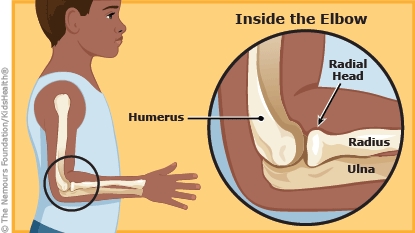Elbow (Radial Head) Fracture and Splint: How to Care for Your Child
A radial head fracture is a type of elbow fracture. It happens when there's a break in the radius bone, which connects the elbow to the wrist. The part of the radius that joins the elbow joint is called the "radial head."
Your child got a splint along with a sling to support it. An orthopedic specialist (bone specialist) will replace the splint with a cast in a few days when the swelling goes down. You can help your child by going to all follow-up visits and taking good care of the splint.


Daily splint care:
-
Remind your child to wiggle the fingers to keep blood circulating normally.
-
Check that the fingers have normal feeling, warmth, and color.
-
Check the edges of the splint: Make sure your child isn't picking at or removing the padding from the edges. Make sure the skin near the splint isn't scratched.
-
Don't put anything in the splint. Make sure your child doesn't put toys, food, or other objects into it.
-
Keep dirt, sand, lotion, and powder away from the splint.
-
Your child should use the sling when up and walking around. Don't let your child wear the sling while sleeping.
-
Keep the splint dry:
-
No swimming.
-
Give sponge baths to kids younger than 5 years old.
-
Older kids should take baths instead of showers.
-
Put a plastic covering over the arm when your child bathes. Put the arm up on something to keep the splint completely out of the water.
-
If the splint is accidentally splashed, gently blow air into it from a hair dryer on the cool setting.
Problems to watch for:
-
Sharp edges: Put tape or moleskin (available at drugstores) on any rough spots.
-
Itching: Tap lightly on the splint or use a hair dryer on the cool setting to blow air in and around the edges. Don't let your child scratch under the splint or put anything into it.
-
Swelling: If the fingers look puffy, raise the arm above the level of the heart for 1 hour. If the swelling doesn't get better, call your health care provider.
Be sure to:
-
Schedule a follow-up visit with the orthopedic specialist as recommended.
-
Have your child avoid gym class, sports, and playground equipment and activities until the orthopedic specialist says it's OK.

-
The pain continues while your child is taking pain medicine.
-
The pain gets worse, especially when your child stretches out the fingers.
-
Your child's fingers stay swollen even after propping up the arm for 1 hour.
-
Your child has a fever.
-
The skin around the splint looks red or raw.
-
The splint:

Your child's fingers tingle or become numb, blue, or pale.

How do elbow fractures happen? This type of fracture can happen when kids hold out their arm to try to stop a fall.
What is a splint? A splint is like a cast and supports the bone, but it is soft part of the way around to allow room for swelling.